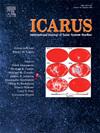Sun Close-Encounter model of long-period comet and Meteoroid Orbit Stochastic Evolution
IF 2.5
2区 物理与天体物理
Q2 ASTRONOMY & ASTROPHYSICS
引用次数: 0
Abstract
The dynamical evolution of long-period comets (LPCs) and their meteoroid streams is usually described with the Sun as the primary body, but over most of their orbits the Solar System barycenter (SSB) is effectively the orbital focus. Detailed numerical integrations show that the orbital elements in the barycentric reference frame are nearly constant, except within the orbit of Jupiter where the comet or meteoroid shifts to a heliocentric orbit. Here we show that this encounter can be modeled in the barycentric frame analogously to how planetary close encounters are treated in the heliocentric frame, with the comet captured into an elliptic orbit about the Sun as it in turn orbits SSB. Modeling the encounters as a two-body interaction in the SSB frame gives a different insight into the dynamics than offered by secular perturbation analyses, and reveals that a large portion of the stochasticity seen in the evolution of the comet’s orbit is due to the Sun’s state relative to SSB at the time of encounter. LPCs sample the Sun’s state randomly at each return, so that a statistical characterization of Sun’s state is sufficient to determine the qualitative evolution of their orbits, including stream dispersion. The barycentric orbital elements are shown to execute random walks well-characterized by Maxwellian distributions. This is superimposed atop a systematic orbital precession induced by planetary torques. Planetary close encounters add a second stochastic component, but this component does not typically dominate the solar perturbations. Based on the statistics of Sun’s state alone, the age of a long-period comet meteoroid stream in a given orbit can be derived to reasonable precision from the observed random dispersion of the angular orbital elements at Earth.
长周期彗星太阳近距离接触模型与流星体轨道随机演化
长周期彗星(lpc)及其流星体流的动力学演化通常以太阳为主要天体来描述,但在它们的大多数轨道上,太阳系质心(SSB)是有效的轨道焦点。详细的数值积分表明,质心参考系中的轨道元素几乎是恒定的,除了在木星轨道内,彗星或流星体转移到日心轨道。在这里,我们展示了这种相遇可以在质心框架中模拟,类似于在日心框架中处理行星近距离相遇的方式,彗星被捕获到围绕太阳的椭圆轨道上,而它又绕着SSB运行。与长期摄动分析相比,在SSB框架中将相遇建模为两体相互作用提供了对动力学的不同见解,并揭示了在彗星轨道演化中看到的大部分随机性是由于太阳相对于SSB在相遇时的状态。lpc在每次返回时随机采样太阳的状态,因此太阳状态的统计特征足以确定其轨道的定性演变,包括流色散。重心轨道元被证明可以很好地执行麦克斯韦分布特征的随机漫步。这是叠加在由行星扭矩引起的系统轨道进动上的。行星近距离接触增加了第二个随机分量,但这个分量通常不会主导太阳扰动。仅根据太阳状态的统计数据,可以从观测到的地球角轨道元素的随机色散中得出给定轨道上长周期彗星流星体流的年龄。
本文章由计算机程序翻译,如有差异,请以英文原文为准。
求助全文
约1分钟内获得全文
求助全文
来源期刊

Icarus
地学天文-天文与天体物理
CiteScore
6.30
自引率
18.80%
发文量
356
审稿时长
2-4 weeks
期刊介绍:
Icarus is devoted to the publication of original contributions in the field of Solar System studies. Manuscripts reporting the results of new research - observational, experimental, or theoretical - concerning the astronomy, geology, meteorology, physics, chemistry, biology, and other scientific aspects of our Solar System or extrasolar systems are welcome. The journal generally does not publish papers devoted exclusively to the Sun, the Earth, celestial mechanics, meteoritics, or astrophysics. Icarus does not publish papers that provide "improved" versions of Bode''s law, or other numerical relations, without a sound physical basis. Icarus does not publish meeting announcements or general notices. Reviews, historical papers, and manuscripts describing spacecraft instrumentation may be considered, but only with prior approval of the editor. An entire issue of the journal is occasionally devoted to a single subject, usually arising from a conference on the same topic. The language of publication is English. American or British usage is accepted, but not a mixture of these.
 求助内容:
求助内容: 应助结果提醒方式:
应助结果提醒方式:


